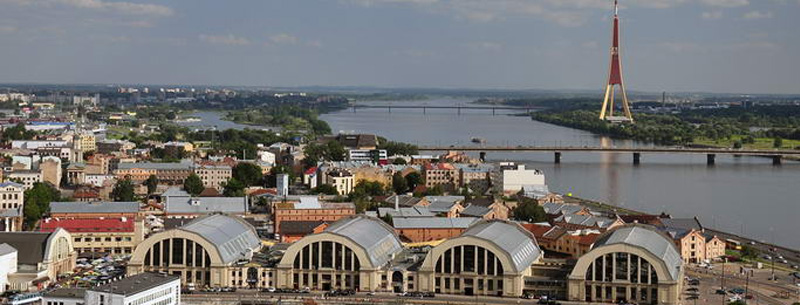Riga, capital city of Latvia
Riga’s big-city vibe makes it the shining metropolitan star of the Baltics. The Latvian capital is vibrant and funky, pulsating with magnetic energy that stays with visitors long after they leave the city. Divided by the Daugava River, the capital mixes quaintness with Art-Nouveau architecture, large parks, an intriguing historic quarter and cobbled streets lined with steeples, glitzy nightclubs and thriving restaurants. The fairy-tale city was once nicknamed the “Paris of the East,” but Riga is quickly making a name for itself thanks to its timeless elegance and lavish beauty.
The most enchanting part of Riga is its Old Town, which can easily pass for any city in Western Europe. Many of the buildings that line the crooked, mainly pedestrianized streets were built in the 17th century, and simply wandering the streets is a great pleasure. Stop at the moving Museum of the Occupation of Latvia to learn about life under both Nazi and Soviet occupations, then head to the nearby St. Peter’s Church. Built in 1209, it is the city’s oldest religious institution, and the tower boasts one of the best views of the city. St. John’s Church, located just a few blocks away, is only slightly less spectacular and definitely worth a visit.
Old Town is also home to the Porcelain Museum, which contains an extensive collection of 19th and 20th-century porcelain artifacts, and the Sun Museum, one of the most bizarre sights in the city. The museum details the importance of sun mythology in Latvian culture, which is surprisingly interesting and thought-provoking.
Other notable museums in Riga include the National Museum of Art, featuring pre-WWII Latvian and Russian masterpieces, and the Museum of the History of Riga and Navigation, whose most interesting pieces include an executioner’s sword from the 16th century and the mummified hand of a criminal.
Further afield lies the Latvian Ethnographic Open-Air Museum, a must-see sight for every visitor to Riga. Located on the outskirts of the capital, the museum grounds are home to transplanted historic buildings from all over the country, including dozens of windmills, farmhouses and churches. Walking through the museum is like taking steps back in time to a simpler bygone era of country living.
To really drink in the culture of Riga, visit the central market that encompasses five hangars near the Old Town. The market is one of Europe’s largest, and the first record of it appeared in 1330. Up to 1,250 sellers crowd the space, which is bursting at the seams with fresh produce, handmade fabrics, local handicrafts and cheap souvenirs. Treat yourself to some Latvian specialties, like freshly salted cucumbers and smoked eel, then sit back with a cup of coffee while you watch the thousands of shoppers go by.
The Spikeri district is another Riga highlight, the city’s center of creative industries born from once-abandoned warehouses. The area’s rebirth has been marked by an influx of cultural organizations, cinemas, music venues, art galleries, cozy cafes and posh restaurants.
One of the most lovely places in the capital is the Bastejkalns park, which includes Japanese and Chinese-inspired pagodas and a Bridge of Love that spans the Pilsetas Canal. Recently married couples solidify their love by leaving locks on the bridge and throwing the keys into the waters below.
Other memorable sights in Riga include the Freedom Monument, the dramatic Museum of the Barricades of 1991, the modern Arsenal Museum of Art, the historic Swedish Gate, Esplanade Park, the spectacular Riga Orthodox Cathedral, the thought-provoking Pharmaceutical Museum and the beautiful Art-Nouveau buildings that line Alberta and Elizabetes streets.
Riga Geographical Location
Riga is the largest city in Latvia and is situated on the central northern coast at the mouth of the Daugava.
The approximate population of Riga is 710,000.
Riga Language
Latvian is the official language of Latvia with a significant percentage of the population speaking Russian.
Riga Predominant Religion
- 64% Unspecified
- 20% Lutheran
- 15% Orthodox
- 1% Other Christian
There have been many dominant religions throughout Latvia’s history but in present-day Latvia the majority of the population is not religious.
Riga Currency
The Lats is the official currency of Latvia.
Riga Climate
The summers in Riga are short and cool while the winters are usually quite cold and accompanied by snow. Humidity is high during the summer months and usually receives slightly more precipitation than the winter.
Riga Main Attractions
- Riga Cathedral
- St Peter’s Church
- Latvian History Museum
Other Attraction in Riga
- The National Latvian Museum of Art
- House of the Blackheads
- Bastejkains Park and Freedom Monument
- Central Market
